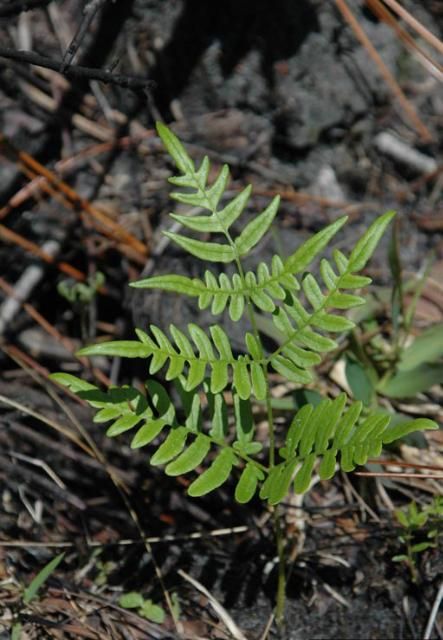Bracken fern is a common perennial widely distributed across the United States (Figure 1). This plant grows well in both wet and dry soil, but seems to prefer semi-shaded environments. Bracken fern is most common along tree lines, in forest openings, and around building borders. Although animals rarely consume bracken fern, they will do so when adequate forage is not available. This is problematic because bracken fern is a well-documented poisonous plant (Knight and Walter 2001). All parts of the plant contain the toxin, but levels are highest in the rhizomes. Generally, horses and swine are most susceptible, while ruminant animals are more tolerant (Knight and Walter 2001). Toxicity from bracken fern (which induces vitamin B1 deficiency) does not usually occur immediately; rather, it is most commonly chronic in nature, requiring repeated exposure to the plant over time. This publication is intended for county Extension faculty as well as owners and managers of grazing lands.

Credit: Chris Evans, River to River CWMA, Bugwood.org
Control of bracken fern has been relatively difficult to achieve because most of the commonly used pasture herbicides are ineffective. Research conducted at UF/IFAS has shown that 2,4-D + dicamba (Weedmaster, others), triclopyr (Remedy Ultra, others), and 2,4-D + aminopyralid (GrazonNext HL) are ineffective (Table 1). These herbicides will often cause treated leaves to die, but resprouting from rhizomes occurs quickly. However, metsulfuron (MSM 60, others) and chlorsulfuron (Telar) have proven to be effective. Nevertheless, some plants began to resprout by eight months after treatment. Considering that bracken fern is a perennial plant, multiple applications may be necessary for complete control. Note that metsulfuron can be safely applied to bermudagrass, but will result in moderate to severe injury if applied to bahiagrass. Chlorsulfuron can be safely applied to both bermudagrass and bahiagrass.
Reference
Knight, A. P., and R. Walter. 2001. A Guide to Plant Poisoning of Animals in North America. Jackson, WY: Teton New Media.
Table 1. Control of bracken fern with postemergence herbicides. Contact: Brent Sellers (sellersb@ufl.edu).